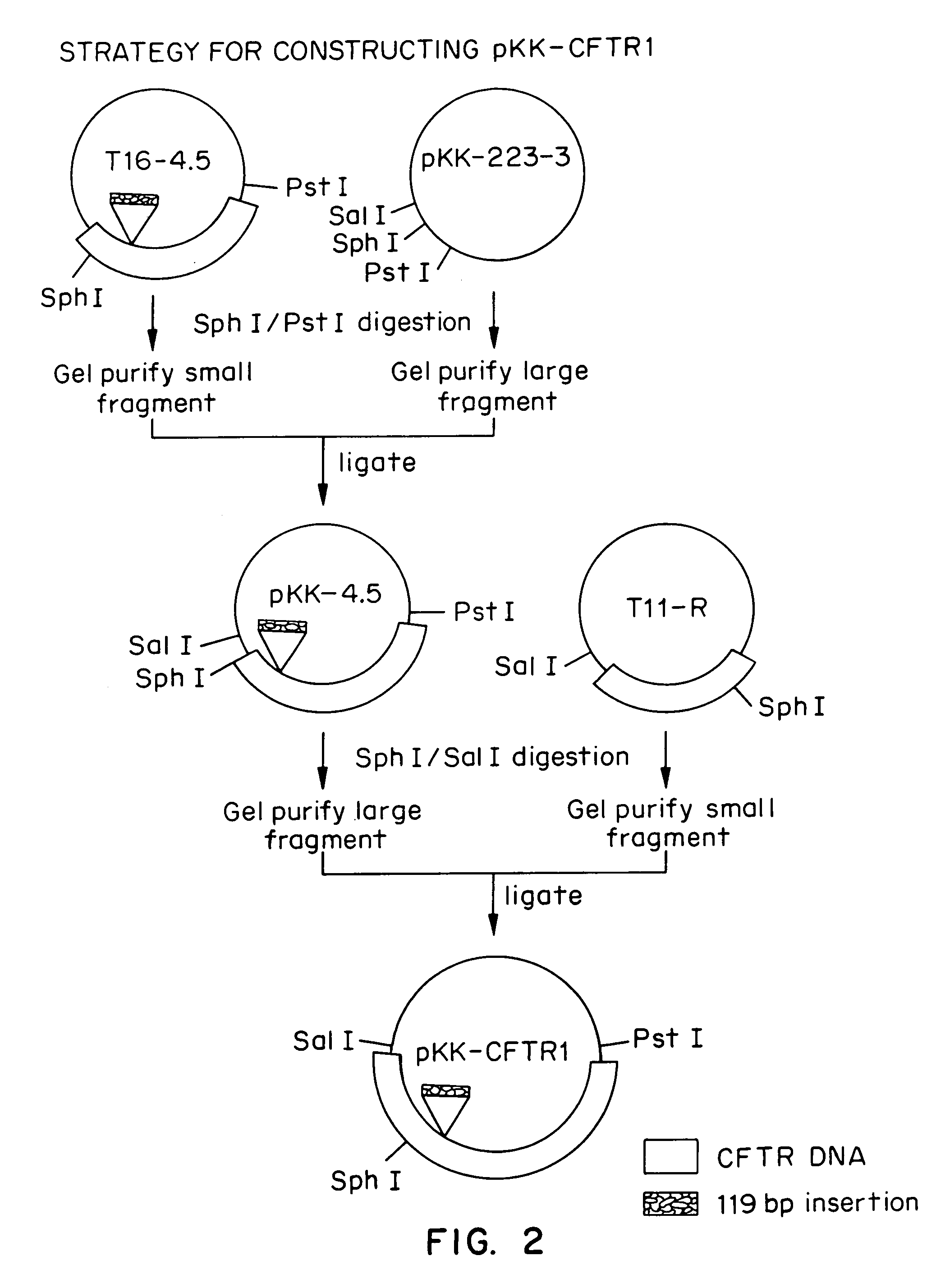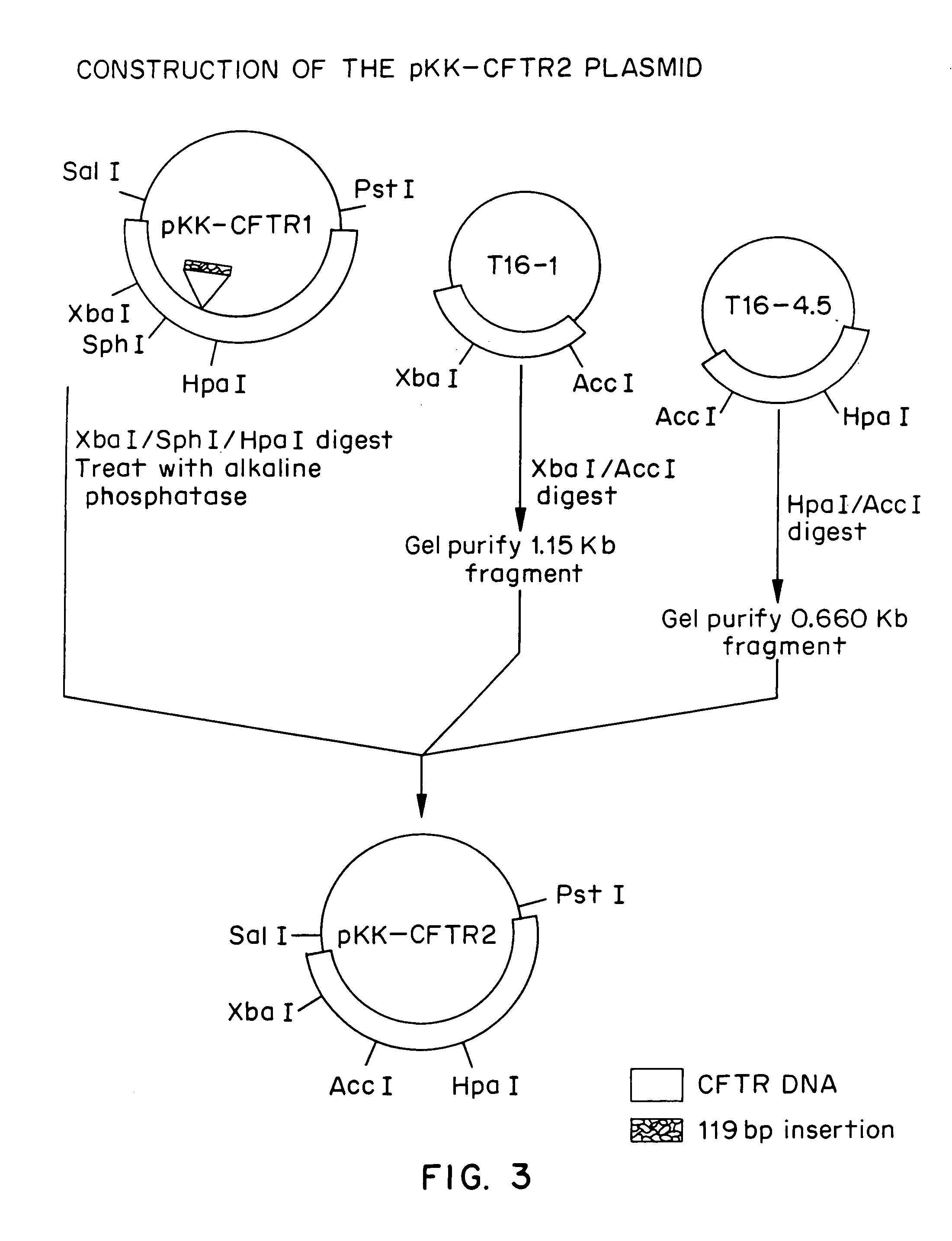DNA molecules stabilized for propagation in bacterial cells that encode cystic fibrosis transmembrane conductance regulator
- Summary
- Abstract
- Description
- Claims
- Application Information
AI Technical Summary
Benefits of technology
Problems solved by technology
Method used
Image
Examples
example 1
Generation of Full Length CFTR cDNAs
[0058]Initial attempts to reconstruct the entire CFTR protein coding sequence in high copy number plasmids similar to those reported by Riordan et al., produced only molecules with internal rearrangements and deletions of coding sequence. Such rearrangements can result, for example, from recombination catalyzed by host cell proteins, and they occur primarily between regions of complete or partial nucleotide sequence identity within a DNA molecule, such as are present at direct or inverted repeat sequences. Although such deletions could be attributed to instability of the CFTR cDNA in E. coli, computer analysis of the CFTR sequence did not reveal an unusual number of direct and inverted sequence repeats within the published CFTR sequence, thereby indicating that the CFTR cDNA should not be inherently unstable in E. coli.
[0059]Nearly all of the commonly used DNA cloning vectors are based on plasmids containing modified pMB1 replication origins and ...
example 2
Improving Host Cell Viability
[0064]An additional enhancement of host cell viability was accomplished by a further reduction in the copy number of CFTR cDNA per host cell. This was achieved by transferring the CFTR cDNA into the plasmid vector, pSC-3Z. pSC-3Z was constructed using the pSC101 replication origin of the low copy number plasmid pLG338 (Stoker et al., Gene 18, 335 (1982)) and the ampicillin resistance gene and polylinker of pGEM-3Z (available from Promega). pLG338 was cleaved with Sph I and Pvu II and the 2.8 kb fragment containing the replication origin isolated by agarose gel purification. pGEM-3Z was cleaved Alw NI, the resultant restriction fragment ends treated with T4 DNA polymerase and deoxynucleotide triphosphates, cleaved with Sph I and the 1.9 kb band containing the ampicillin resistance gene and the polylinker was isolated by agarose gel purification. The pLG338 and pGEM-3Z fragments were ligated together to produce the low copy number cloning vector pSC-3Z. pS...
example 3
Alternate Method for Improving Host Cell Viability
[0066]A second method for enhancing host cell viability comprises disruption of the CFTR protein coding sequence. For this purpose, a synthetic intron was designed for insertion between nucleotides 1716 and 1717 of the CFTR cDNA. This intron is especially advantageous because of its easily manageable size. Furthermore, it is designed to be efficiently spliced from CFTR primary RNA transcripts when expressed in eukaryotic cells. Four synthetic oligonucleotides were synthesized (1195RG, 1196RG, 1197RG and 1198RG) collectively extending from the Sph I cleavage site at position 1700 to the Hinc II cleavage site at position 1785 and including the additional 83 nucleotides between 1716 and 1717 (see FIG. 6). These oligonucleotides were phosphorylated with T4 polynucleotide kinase as described by Sambrook et al. mixed together, heated to 95° C. for 5 minutes in the some buffer used during phosphorylation, and allowed to cool to room tempera...
PUM
| Property | Measurement | Unit |
|---|---|---|
| Electrical conductance | aaaaa | aaaaa |
Abstract
Description
Claims
Application Information
 Login to View More
Login to View More - R&D
- Intellectual Property
- Life Sciences
- Materials
- Tech Scout
- Unparalleled Data Quality
- Higher Quality Content
- 60% Fewer Hallucinations
Browse by: Latest US Patents, China's latest patents, Technical Efficacy Thesaurus, Application Domain, Technology Topic, Popular Technical Reports.
© 2025 PatSnap. All rights reserved.Legal|Privacy policy|Modern Slavery Act Transparency Statement|Sitemap|About US| Contact US: help@patsnap.com



